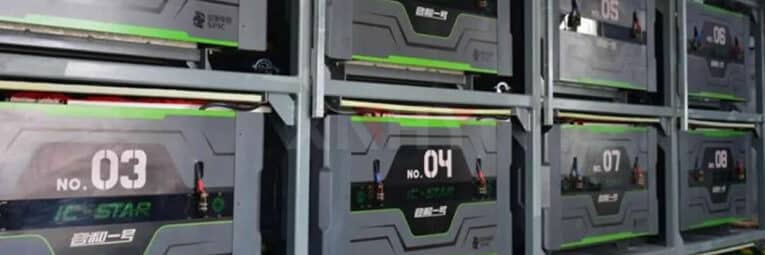
- Home
- All Posts
- Battery Material
- Bipolar Plate
- Bipolar Plate for Iron-chromium Redox Flow Battery
Blog

Bipolar Plate for Iron-chromium Redox Flow Battery
Bipolar plate is a critical component of Iron-chromium redox flow battery, which is used to separate positive and negative reaction medium, and connect the single cells in series to form an electric stack, also used as a current collector to gather and transmit current, convert the chemical energy in the solution into electrical energy. The reaction process is reversible, and realize charging and discharging. As one of the saftest energy storage solutions, Iron-chromium redox flow battery has many advantages such as long service life, convenient recovery, reliable operation, etc, power and storage capacity also can be customized according to requirements.
Application of bipolar plates for Iron-chromium redox flow battery
The Iron-chromium flow battery(ICB) is a redox flow battery (RFB). In addition to good chemical stability, the bipolar plate of ICB has low permeability, high conductivity and certain mechanical strength. The electrolyte solution is generally dilute hydrochloric acid solution containing iron salt and chromium salt, so the materials are required to have certain corrosion resistance. Based on materilas, the common bipolar plates are mainly divided into metal bipolar plates, graphite bipolar plates and conductive plastic bipolar plates.
Because the corrosion-resistant metal bipolar plate material is extremely expensive, it’s not proper for large-scale commercial applications. The relatively low-cost lead material is toxic and easy to be oxidized, and the stainless steel material is difficult to withstand strong acid corrosion. In general, the metal bipolar plates are not suitable for the long-term stable operation of the iron chromium flow battery(ICB). Graphite materials can be acid resistant and have excellent electrical conductivity, but the strength of hard graphite plates is poor and the cost is high. In practical applications, polymer is generally added to prepare composite graphite bipolar plates to optimize their mechanical properties. Conductive plastic bipolar plates are generally made of conductive raw materials and polymer resins, with low cost and strong plasticity, can be manufactured by injection and molding process, suitable for large-scale production. The conductive plastic bipolar plate is more corrosion-resistant than the metal bipolar plate, and the preparation process is easier than the graphite bipolar plate. The bipolar plates for iron-chromium flow battery with low resistivity and good mechanical properties can be obtained by optimizing the process formula.
Advantages and disadvantages of iron-chromium flow battery
Comparing to with other energy storage batteries such as lithium battery, lead-acid battery, sodium sulfur battery and redo vanadium flow battery, iron chromium flow battery has the following inherent advantages:
1) Low cost. The electrolyte solution of ICB uses iron and chromium as the active materials, which are rich in raw materials and easy to obtain. It is a sustainable low-cost energy storage battery technology.
2) Low toxicity. Compared with VRFB which is more widely used, the toxicity and corrosion of iron chromium flow battery are very low, and it is easy for treating of environmental protection.
3) High safety. Comparing to combustible lithium-ion batteries, the electrolyte solution of the ICB is stored in two separated liquid storage tanks, it is safer to operate under normal temperature and pressure.
4) Long life. The cycle life of iron chromium flow battery can reach 20000 times, and its service life is equal to that of VRFB, far higher than that of lithium-ion battery, lead-acid batteries and sodium sulfur batteries.
5) Wide adaptability. The operating temperature of iron-chromium redox flow battery is more extensive than that of other flow batteries. The electrolyte solution can operate between – 20 ℃ and 70 ℃.
6) Customized modular design. The power of ICB depends on the number of battery stacks, and the capacity depends on the amount of electrolyte solution. The number of battery stacks and the capacity of electrolyte can be freely changed according to needs.
Of course, as a new redox flow battery, the industrial chain of iron chromium battery is not as mature as that of lithium-ion or vanadium flow battery. As a negative electrode material, The activity of chromium ion is relatively weak, and there is a gap in energy density and system efficiency. It is believed that in the future, driven by large-scale commercialization, The development and progress of bipolar plate technology of iron-chromium redox flow battery will occupy a place in the field of energy storage.
About Mr. Zhou
Search
Recent Posts
-
Manufacturing Process of Ca... 11/28/2024
-
Application of Flexible Gra... 05/14/2024
-
PEM Water Electrolysis for ... 04/12/2024
-
Application of Bipolar Memb... 01/09/2024
-
Membrane Electrode Assembly... 11/27/2023
Categories
- All Posts (24)
- Flow Battery (11)
- Battery Material (20)
- Bipolar Plate (13)
- Membrane (3)
- Felt Electrode (1)
- MEA (3)
- Fuel Cell (5)
Contact Info.
Recent Post
-
Manufacturing Process of Ca... 11/28/2024
-
Application of Flexible Gra... 05/14/2024
-
PEM Water Electrolysis for ... 04/12/2024
-
Application of Bipolar Memb... 01/09/2024
-
Membrane Electrode Assembly... 11/27/2023


